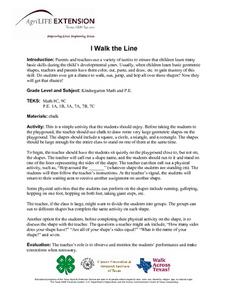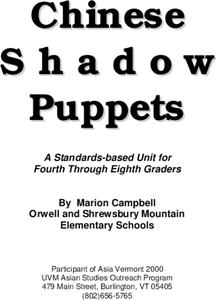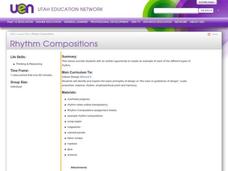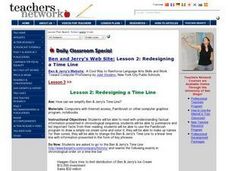Curated OER
Goals And Objectives for Units of Study And Lesson Plans
Students determine the role that goals and objectives play in lesson planning. They identify the difference between goals and objectives.
Curated OER
I Walk the Line
Students walk, run, jump, and hop all over and around geometric shapes. They identify the shapes by running to and standing on the called out shape.
Curated OER
Ancestor Stories
Fourth graders interview their familly members to explore how they settled in Utah. They create their pioneer story with illustrations and present their information to the class.
Curated OER
Vibrations
Sixth graders use rubber bands, textbooks, pencils, rulers and yo-yos to experiment with the concept of vibrations. They observe changes in pitch according to the speed of vibrations and record their observations in a journal.
Curated OER
Violets, Daffodils, Roses and Thorn
Fourth graders complete a variety of exercises and activities surrounding the scientific and artistic properties of the parts and processes of a plant/flower.
Curated OER
Chinese Shadow Puppets
Students explore the art of Chinese shadow puppetry. They create puppets, develop and rehearse scripts and perform a show in front of the class.
Curated OER
Everything Has Parts
Students investigate and explore common objects to discover and identify their parts. They also are encouraged to discuss the need for specific parts and what happens when a part is missing from the whole.
Curated OER
ESOL Transportation and Travel
Students discuss importance of reading and understanding traffic signs then list the common road signs. They complete "Traffic Signs" activity
sheet and Compare and contrast traffic signs and driving practices in the U.S. with traffic...
Curated OER
Using Science Skills to Investigate Japanese Quail
Sixth graders explore Japanese Quail. They generate and record scientific questions about the quail. Students gather information from various sources and record their data. They compose an inquiry report and include it in a portfolio.
Curated OER
Rhythm Compositions
Students investigate the concepts that focuses upon the musical rhythms. They conduct class discussion and use questions in order to clear up any misconceptions. Students create art compositions that illustrate rhythm and then each one...
Curated OER
Family Quilts Keep Us Warm
Students discuss and describe the differences and similarities in families. After reciting finger plays about families, they draw pictures of their own families. Next, they incorporate their family pictures into a paper quilt.
Curated OER
A Quick Look at the Makah Whaling Issue
Students discuss the idea of values and how they are different for different people and cultures. Using the Internet, they read about the Makah whaling issue affecting the Pacific Northwest. They discuss who has the right and authority...
Curated OER
Redesigning a Time Line
Middle schoolers review how Ben and Jerry's ice cream is made to begin the lesson plan. Using the internet, they view a timeline on the history of the company. They use a software program to make an ice cream cone and color the ice cream...
Curated OER
Basic Geometric Constructions
Students observe and demonstrate a variety of basic geometric constructions using the Triman Safety Compass. Using the compass, they draw circles, bisect a line segment, construct an angle, bisect an angle, copy an angle, and create...
Curated OER
What Boat Designs Float the Best?
Fifth graders investigate buoyancy by conducting a science experiment. In this water properties lesson, 5th graders predict which of their different paper boat designs will float for the longest period. Students conduct the experiment...
Curated OER
Colorful Sentence Writing
Fifth graders practice expressing themselves through writing. In this language arts lesson, 5th graders study the parts of speech and apply to writing sentences.
Curated OER
Science with Mud!
Eighth graders give some examples of chemical reactions they see everyday. In this chemistry lesson, 8th graders investigate how much water soil can hold. They collect data and compare results with others.
Other
Abc Art, Books, and Creativity: Book Instructions
With this resource, students can learn how to make a variety of handmade books with simple paper folding techniques. All directions are easy to follow and come in a printable pdf format.
TeachEngineering
Teach Engineering: Understanding Communication With a Robot
Student pairs first act out the instructions a robot is given with one person providing instructions and the other person following the instructions. This activity helps students understand how a robot is programmed and with what type of...
TeachEngineering
Teach Engineering: Be "Cool" With Popsicle Engineering
Beginning kindergarteners are introduced to science and engineering concepts through questions such as "What is a Scientist?" and "What is an Engineer?", and go on to compare and contrast the two. They are introduced to five steps of the...
Other
Kids Online: Writing Your Own Web Pages (Html)
The HTML code for a very simple web page is examined and explained line by line. Next, follow the instructions to create your own HTML file, view it in your Web browser, and see the effects of making small changes to the code.
Math Is Fun
Math Is Fun: Addition in Columns
Simple instruction on how to perform addition of two- and three-digit numbers using columns. View animated examples and follow links to column addition worksheets.
American Museum of Natural History
American Museum of Natural History: O Logy: Stuff to Do: Dna in a Blender
Follow these illustrated instructions to conduct a simple experiment in separating DNA from an onion!
Science Education Resource Center at Carleton College
Serc: Investigating Discovering What Plants Need for Photosynthesis
This activity will be used prior to any direct instruction for photosynthesis. In this inquiry lab, students design and conduct simple experiments using elodea and Bromthymol blue to determine whether plants consume or release carbon...

























